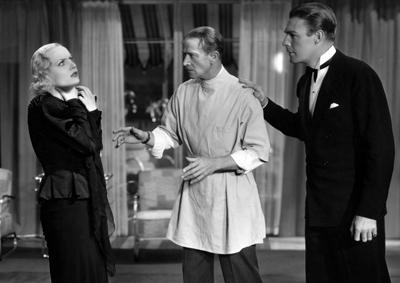“..this picture evolves as one of the dramatic smashes of the year.” — Billboard
Directed by Charles Vidor
Protests from the playwright and producers notwithstanding, New Yorkers who flocked in the fall of 1933 to see Elizabeth McFadden's play Double Door knew it was inspired by the Wendel family of Manhattan, a Gilded Age dynasty of fabulously wealthy eccentrics. What could be more gothic than seven sisters sequestered in a gloomy mansion, tainted by madness, forbidden to marry, presided over by an avaricious brother? As the 19th-century mansions along Fifth Avenue fell before the booming commerce of the 20th-century, the Wendels became the stuff of New York legend. By 1914 their mansion stood a solitary sentinel against the hue and cry of the emergent commercial district, staring unblinking at the Lord & Taylor department store across the street at Fifth Avenue and 39th Street. When the last of the line, Ella, died in 1931 at age 78, New York gasped: she had left $100 million, it was reported, and no heirs.
Double Door is a dark riff on this legend, compressed into a three-act melodrama. The scion became a tyrannical spinster, holding in thrall a neurotic sister and a demoralized kid brother. When the brother makes a bid for sanity and freedom and takes a bride, the wheels of madness begin to turn.
Paramount brought Anne Revere and Mary Morris directly from the stage to recreate their roles as the emotionally battered Caroline and the dominatrix Victoria. The film is an absolute triumph for Morris (only 39 years old, she credibly plays two decades older), whose only film this was. Revere would split her time between stage and pictures, receiving three Oscar nominations and one win. The ingénue Evelyn Venable, as the butterfly caught in Victoria's web, retired from films in 1943 and forged a second career as a classics professor at UCLA.
Double Door is the best kind of filmed stage play, with a strong script and a director who respects his actors. Director Charles Vidor imposes film technique judiciously to punctuate a key revelation with a camera move, an unexpected angle or a lighting shift. One of these is a meticulously plotted in-camera effect breathtaking in its subtlety.
Double Door was a template for the Gaslight school of cat-and-mouse thrillers that would proliferate on the New York and London stage over the next forty years, terrain that director Vidor would embrace again with Ladies in Retirement (1941).
Scott MacQueen
Paramount Productions, Inc. Producer: E. Lloyd Sheldon. Screenwriters: Gladys Lehman and Jack Cunningham. Based on the play by: Elizabeth A. McFadden, suggested by Hermine Klepac. Cinematographer: Harry Fischbeck. Editor: James Smith. With: Evelyn Venable, Mary Morris, Anne Revere, Kent Taylor, Sir Guy Standing.
35mm, b/w, 75 min.
Preserved in conjunction with Universal Pictures from the 35mm nitrate studio composite answer print. Laboratory services by The Stanford Theatre Film Laboratory, Audio Mechanics, DJ Audio, Simon Daniel Sound. Special thanks to Bob O’Neil.






 Mobile Navigation
Mobile Navigation

